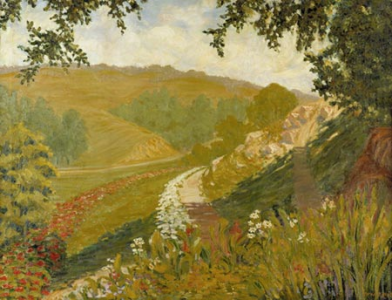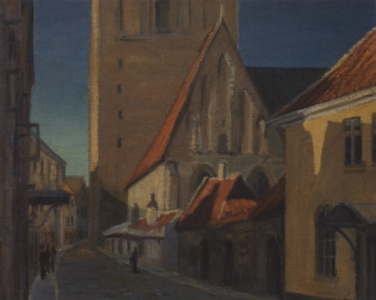Biography
Byron Bennett Boyd was born in Wichita, KS in 1887. He attended public schools in Denver, CO and had the good fortune to be able to study under Jean Mannheim while he was still in high school, as Mannheim was teaching at the Denver Art School briefly in 1903. There followed three years at the University of Colorado, after which Boyd received a BA degree from Northwestern University in 1910. He continued his studies in New York and received an MA from Columbia University in 1912. While in New York he also studied at the National Academy of Design with Harry Leith-Ross and Henry Hensche.
In 1914 Boyd moved to Des Moines, IA, where he worked as a designer for the prominent architectural firm Proudfoot, Bird and Rawson. He set up his own architectural shop, Boyd & Moore, in 1916, which he would run for another ten years. During World War I he headed a division designing bases for submarines.
Working as an architect, Boyd designed many important structures. These included private dwellings: Salisbury House (1923), his own house (1924, cited in the National Register of Historic Places as the "Byron and Ivan Boyd House"), the Ralph Rollins House (1926) and Helfred Farms (1928). Boyd also received commissions for several significant public buildings: the Insurance Exchange Building (1923), the Memorial Union at the University of Iowa (1925), and the Iowa National Bank Building (1931).
Despite his success as an architect, after 1926 Boyd decided to focus more on art. He served as President of the Iowa Artists Club from 1928-1932. In 1929 he went to Paris. Between this trip and others, Boyd traveled widely, visiting many parts of Europe and going as far as North Africa. Back in Iowa, he had a solo exhibit at the Davenport Municipal Art Gallery. He joined Grant Wood's Stone City Art Colony in 1932. He assisted the muralist Boardman Robinson on several projects and received two commissions for Post Office murals: "Arrival of the First Train" for Osceola, IA (1936) and "Hollanders Settle in Pella" in Pella, IA (1938). Meanwhile his work was being exhibited nationally: the Second Biennial Exhibition of Contemporary American Painting at the Whitney Museum of Modern Art in New York (1935), and an exhibit at the Corcoran Gallery in Washington, DC (1937).
Boyd's wife, Ivan Bloom Hardin, ran a publishing company from the early 1920s through the 1950s. Boyd himself published four plays: "An Amateur Hamlet," "The Strongest," "They Cannot Return," and "Mushrooms."
Following a painting excursion to Mexico in 1939, Boyd took up a position as Director of the Art Department at Drake University. He held that position from 1939-1944 and oversaw increased attendence and improved accreditation during his tenure. In 1943 Boyd joined the Des Moines planning and zoning commission. Ill health forced an early retirement in 1944, after which Boyd and his wife moved to California. He died in La Jolla, CA in 1959.



Critical Analysis
Given his versatility, it's hard to evaluate the work of Byron Bennett Boyd. Should we regard him as an architect or a painter? Or perhaps even a playwright. His architectural credentials were very solid, and his accomplishments in that field indisputable. We have few examples of his artwork, but the ones that are available suggest that he liked to experiment with a number of different styles.
One of Boyd's most intriguing easel paintings is entitled "In the Minds of Men, Disorder." This painting shows organized assemblies in Germany, Russia, France, England and the United States. The Russian assembly is something of an echo of another Boyd painting, "The New God," that showed a long line of people in a bleak landscape in front of Lenin's tomb. The U.S. assembly, in the foreground of the painting, is the least militaristic and most individualistic of the assemblies. Overhead and in the distance are ominous forebodings of warfare. One guesses that this painting must have been produced on the eve of World War II and must have reflected the artist's anxiety over the upcoming conflict.
Murals
- Osceola, Iowa - Post Office: Arrival of the First Train
- Pella, Iowa - Post Office: Hollanders Settle in Pella
References
- Byron and Ivan Boyd House.National Register of Historic Places Nomination (2004). Includes a detailed biography of Boyd.
- Byron Bennett Boyd (askART).
- George Shane, Great Drama and Realism in Boyd's Art, The Des Moines Register October 18 (1950).
- Iowa's Notable Dead..., The Annals of Iowa Volume 35, Number 2, Fall (1959).